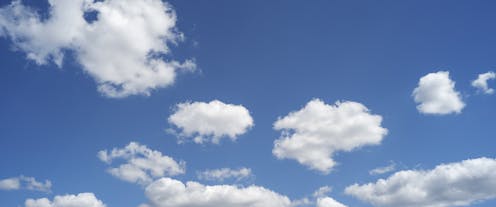Why is the sky blue?
- Written by Daniel Freedman, Dean of the College of Science, Technology, Engineering, Mathematics & Management, University of Wisconsin-Stout

A rainbow represents all the different components[10] that make up sunlight. As that light passes through the water droplets suspended in the air[11], it is broken up into the component colors called the visible spectrum – red, orange, yellow, green, blue, indigo and violet, more easily remembered as ROY G. BIV[12].
Light at the blue end of the rainbow is scattered more efficiently than the other colors. It is as if the tennis balls are very selective in terms of which marbles they eat, and they prefer the blue ones over the other colors.
The result is that the blue light is scattered across the sky so you see blue everywhere on sunny days. The rest of the colors mainly travel straight through the atmosphere.
Redder when the Sun sets and rises
Of course, the sky is not always blue.
And Rayleigh scattering also explains why the sky tends to be reddish when the Sun is close to the horizon – at sunrise and sunset.
When the Sun is near the horizon, its light passes through a lot more of the atmosphere to reach the Earth’s surface than when it is directly overhead. The blue and green light is scattered so well that you can hardly see it. The sky is colored, instead, with red and orange light.
Colors mean a lot to us in so many different ways. Understanding the science behind colors and expressing ourselves through art with colors have been important for humans for our entire recorded history. That’s something to keep in mind as you decide what color shirt to wear tomorrow morning.
NASA’s Space Place explains why the sky is blue.Hello, curious kids! Do you have a question you’d like an expert to answer? Ask an adult to send your question to CuriousKidsUS@theconversation.com[15]. Please tell us your name, age and the city where you live.
And since curiosity has no age limit – adults, let us know what you’re wondering, too. We won’t be able to answer every question, but we will do our best.
References
- ^ Curious Kids (theconversation.com)
- ^ CuriousKidsUS@theconversation.com (theconversation.com)
- ^ my own field of chemistry (www.uwstout.edu)
- ^ blue portion of sunlight (spaceplace.nasa.gov)
- ^ physicists call scattering (spaceplace.nasa.gov)
- ^ John William Strutt (www.nobelprize.org)
- ^ Rayleigh scattering (doi.org)
- ^ carbon dioxide or methane on the global climate (theconversation.com)
- ^ peepo/E+ via Getty Images (www.gettyimages.com)
- ^ rainbow represents all the different components (theconversation.com)
- ^ water droplets suspended in the air (www.scientificamerican.com)
- ^ ROY G. BIV (faculty.washington.edu)
- ^ hiroyuki nakai/Moment via Getty Images (www.gettyimages.com)
- ^ Elenakirey/iStock via Getty Images Plus (www.gettyimages.com)
- ^ CuriousKidsUS@theconversation.com (theconversation.com)
Authors: Daniel Freedman, Dean of the College of Science, Technology, Engineering, Mathematics & Management, University of Wisconsin-Stout
Read more https://theconversation.com/why-is-the-sky-blue-246393

